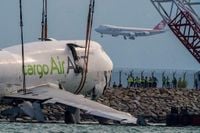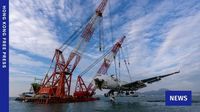In the early hours of October 20, 2025, tragedy struck Hong Kong International Airport (HKIA) when a Boeing 747 cargo plane, operated by Turkey-based ACT Airlines and wet leased to Emirates, veered off the North Runway during landing and plunged into the sea. The incident, which remains under active investigation, stands as Hong Kong’s deadliest aviation disaster in 26 years and has left the city’s aviation community grappling with shock and sorrow.
According to Hong Kong Free Press, the accident unfolded as the Air ACT cargo plane, arriving from Dubai, collided with a stationary patrol vehicle on the tarmac. Both the aircraft and the patrol car were sent hurtling into the waters off the airport’s North Runway. Four crew members aboard the aircraft managed to evacuate via an emergency slide and were promptly taken to the hospital. However, the two ground staff in the patrol vehicle were not as fortunate—one was certified dead at sea, and the other succumbed to injuries at the hospital. The loss has reverberated throughout the local aviation and ground services communities, prompting widespread condolences and a renewed focus on safety protocols.
Immediately following the crash, the Airport Authority Hong Kong (AAHK) launched a complex and meticulously coordinated salvage operation, enlisting the expertise of the Guangzhou Salvage Bureau. Two specialized vessels, the Nan Tian Xiang and Nan Tian Peng, with lifting capacities of 350 and 500 tonnes respectively, were dispatched to assist in the recovery efforts. As reported by CAAS International, professional divers and engineers worked tirelessly for several days, braving challenging conditions to recover key sections of the aircraft from the sea.
The salvage operation unfolded in carefully planned stages. On October 24, 2025, at 22:41 local time, the tail section of the Boeing 747 was successfully hoisted from the water and placed on a barge for inspection by the Air Accident Investigation Authority (AAIA). Earlier that same day, one of the engines and the landing gear were retrieved from the seabed. By the evening of October 26, the main fuselage had been raised and secured on a barge, ready for transfer to a designated storage site where it would undergo further examination by investigators. The final pieces of wreckage were slated for recovery by October 27, marking the completion of the salvage operation.
Throughout the recovery, HKIA’s flight operations continued largely as normal, a testament to the airport’s robust contingency planning. However, the North Runway, where the crash occurred, remained closed from October 23 to facilitate the removal of the stricken aircraft and ensure the safety of salvage crews. The closure and subsequent reopening were managed with minimal disruption to the broader airport schedule, according to statements from airport officials.
Before the physical recovery began, experts conducted an underwater sonar survey to map the wreckage and plan the safest approach for lifting the large and unwieldy aircraft sections. The operation required not just brute force, but also finesse—salvage teams had to adjust the position of the fuselage in mid-air before gently lowering it onto a waiting vessel, as described by The Associated Press.
Critical to the ongoing investigation was the retrieval of the aircraft’s flight data recorder and cockpit voice recorder—often referred to as the “black box.” These devices were recovered on October 24 and sent to a laboratory for preliminary examination. Their contents are expected to provide crucial insights into the final moments before the crash, potentially shedding light on whether mechanical failure, human error, or some combination thereof contributed to the disaster.
The investigation itself is a truly international effort. Alongside Hong Kong’s AAIA, representatives from the U.S. National Transportation Safety Board, Turkey’s Transport Safety Investigation Center, and technical experts from Boeing are all participating. According to AP, the AAIA has pledged to release a preliminary report within one month, while the full investigation is likely to take considerably longer. The United States sent a five-person team of aviation safety investigators to assist Hong Kong authorities, underscoring the global significance of the incident.
In a news conference following the crash, Steven Yiu, the airport authority’s executive director for airport operations, stated that “weather and runway conditions met standards during the crash, while mechanical and human factors were yet to be investigated.” He emphasized that airport officials had given the correct instructions to the plane and that signs on the runway were in place to guide aircraft. However, he acknowledged the unusual nature of the event, noting, “Normally, the plane is not supposed to turn towards the sea.” According to BBC News, Yiu explained that the aircraft crashed through fencing alongside the runway after striking the patrol car, which was traveling on a service road on the opposite side of the fence.
The human toll of the disaster has not gone unnoticed. Air ACT, in a statement cited by Hong Kong Free Press, extended its condolences to the families of the two workers who died and affirmed its commitment to cooperating fully with the ongoing investigation. The Association for the Rights of Industrial Accident Victims reported that the families of the deceased had met with representatives from the Transport and Logistics Bureau, the Turkish consulate, and Air ACT’s managing director. Emergency relief payments have been offered as ex gratia compensation to support the bereaved families during this difficult period.
This crash is the deadliest aviation incident in Hong Kong since 1999, when a China Airlines flight from Bangkok flipped over and caught fire while landing, resulting in three fatalities. The memory of that earlier disaster looms large, adding a somber historical context to the current tragedy and reinforcing the imperative for rigorous safety standards in one of the world’s busiest aviation hubs.
As the city awaits the findings of the AAIA’s preliminary report, questions linger about the precise sequence of events that led to the aircraft’s catastrophic deviation from the runway. Investigators are poring over every detail—weather data, maintenance records, crew actions, and airport procedures. The hope is that lessons learned from this incident will help prevent future tragedies, ensuring that Hong Kong’s skies remain among the safest in the world.
For now, the families of the victims, the aviation community, and the city as a whole are left to reflect on a stark reminder of the risks inherent in air travel—and the resilience required to recover, learn, and move forward.





